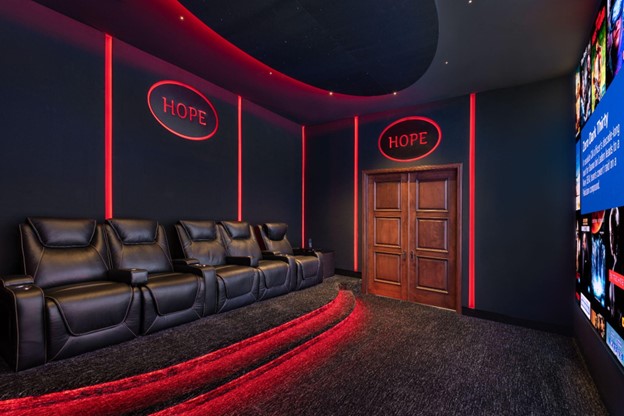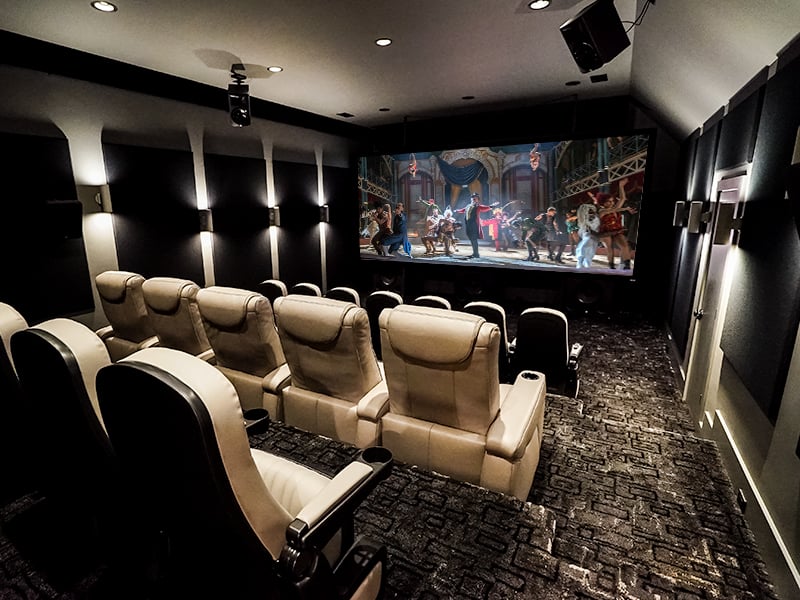Home Theater 101: Everything You Need to Know for a Motion Picture Experience at Home
Developing a home cinema that measures up to the motion picture experience of a business theater involves mindful factor to consider of numerous parts, consisting of display choice, audio systems, and space format. Whether you are considering the suitable screen dimension or the intricacies of surround noise, comprehending these basics is vital.
Choosing the Right Screen
When establishing a home cinema, choosing the best screen can make or damage the checking out experience - tampa home theater installation. The screen functions as the focal point of your configuration, influencing photo high quality, viewing angles, and total visual. Key factors to take into consideration consist of screen resolution, dimension, and type
First, establish the suitable display size based upon your room measurements and seating distance. A basic standard is to sit about 1.5 to 2.5 times the diagonal display dimension for optimum viewing. Next, pick in between various screen types, such as fixed-frame, mechanized, or retractable screens, each offering distinct advantages. Fixed-frame displays normally offer the ideal picture top quality, while motorized choices enable versatility in room usage.
Resolution is another important factor. For a genuinely immersive experience, take into consideration a screen developed for 4K and even 8K content, guaranteeing intensity and quality. Additionally, think about the display's gain, which influences illumination and comparison; a higher gain can enhance brightness in well-lit spaces, while a reduced gain might be preferable for darker atmospheres.
Selecting Sound Equipment
Audio devices is a crucial element of any type of home cinema system, significantly improving the general watching experience. The choice of audio equipment can figure out the depth, clarity, and immersion of noise, vital for developing a motion picture ambience.
When picking audio tools, take into consideration a border audio system, which commonly consists of a receiver, numerous audio speakers, and a subwoofer. A 5.1 or 7.1 channel system is recommended, where the first number stands for the audio speakers and the second the subwoofer, offering an immersive soundscape. The receiver is the heart of the system, managing sound and video clip signals, and ought to support modern formats like Dolby Atmos for a boosted spatial experience.
Quality audio speakers are necessary; appearance for designs that offer a balanced audio account with good bass response. Floor-standing audio speakers can create richer sound, while shelf alternatives conserve area. Furthermore, think about wireless alternatives for simplicity of installment, although wired systems frequently deliver superior performance.

Ideal Seating Plans
Producing a suitable home cinema experience pivots substantially on ideal seating plans. The arrangement of seats plays a crucial role in both convenience and watching top quality, straight impacting the overall motion picture experience.
First, take into consideration the display size and viewing range. A typical guideline is to place seats at a range around 1.5 to 2.5 times the diagonal dimension of the display. This guarantees an immersive experience without straining the eyes.
Next, altitude is important. If your seating is in a tiered layout, the back rows must be greater than the front to stay clear of blockages. For level seating, ensure that the front row is not also close to the display, and that every person has a clear view.
Moreover, take into consideration the plan in terms of social characteristics. Team seating can enhance the common experience, while specific seats might be favored for individual watching.

Last but not least, prioritize convenience with ergonomic seating that sustains extensive viewing durations. Integrating recliner chairs or supported seats can considerably boost the experience, making the home theater a recommended destination for both enjoyment and leisure.
Lighting and Atmosphere
Reliable lighting and atmosphere are essential elements of a properly designed home theater, as they substantially affect the seeing experience. The ideal lights can enhance the cinematic feeling, while inadequate choices can interfere with it. For ideal outcomes, take into consideration a layered lighting technique that consists of ambient, job, and accent lighting.
Ambient lighting offers general lighting, making certain that the space is not completely dark, which can strain the eyes. Dimmer switches are extremely suggested, permitting for adjustments based on the material being checked out. Task lighting, such as wall sconces or floor lamps, uses practical lighting for activities like reading or navigating the area without disrupting the overall atmosphere.
Accent lights can be made use of to highlight building functions or produce prime focus, adding deepness and rate of interest to the room. LED strip lights behind screens or along racks can supply a subtle glow that boosts the visual experience without overwhelming the visitor.

Wiring and Installation Tips
A well-planned wiring setup is essential for achieving optimum efficiency in your house movie theater system. Proper wiring not just guarantees premium audio and video signals yet likewise enhances the overall visual of your area. Begin by drawing up your design, determining where each part will be learn this here now positioned, including your screen, speakers, and receiver.
When choosing cords, focus on premium, properly gauged circuitry to decrease signal loss. HDMI cables must be utilized for video clip connections, while audio speaker cable should match the requirements of your speakers and amplifier. Go with in-wall rated wires to follow safety and security requirements and maintain a clean appearance.

Verdict
In recap, producing an extraordinary home theater experience needs mindful consideration of numerous elements, consisting of display selection, audio tools, seating arrangements, illumination, and circuitry. Each element plays a critical role in accomplishing optimum performance and atmosphere, inevitably enhancing the pleasure of home amusement. By prioritizing these elements, a motion picture ambience can be effectively duplicated, permitting for immersive viewing experiences that match typical theater settings. Attention to detail in each location is crucial for overall complete satisfaction.
Creating a home theater that rivals the motion picture experience of a business theater includes cautious consideration of multiple components, consisting of display my review here choice, audio systems, and area layout.When establishing up a home theater, choosing the appropriate screen can make or break the seeing experience. Next, choose in between numerous screen types, such as fixed-frame, mechanized, or retracting screens, each offering distinct benefits. For an absolutely immersive experience, take into consideration a screen developed for 4K or also 8K web content, making sure sharpness and clarity.In recap, producing an outstanding home movie theater experience requires mindful factor to consider of various components, consisting of screen option, audio devices, seating setups, illumination, and wiring.